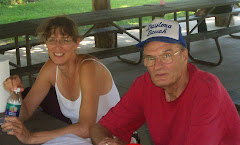We spent the day at the Cleft Palate Clinic. We saw an x-ray video of Maggie speaking, and we saw the aerial view of the top of the back of her throat while speaking too. She's got very good movement in her palate, as well as lateral movement in the sides of her throat that's nearly average. The speech pathologist rated her as having "moderate hypernasality." One small point of her palate can reach all the way to the back of her throat to shut off air supply to her nose while speaking, but WAY too much air is leaking through into her nose.
So she will be having another surgery. For those of you who know about vcfs surgeries, it'll be the sphincter, not the flap. It allows for less obstruction of the airway than does the flap surgery. Basically, she will have some muscle tissue near her tonsils cut and wrapped around the back of the inside of her throat. That will fill up space, making it easier for the palate to reach to the back of the throat, and also make for less work to pull in the sides of her throat too.
Both the pathologist and the ENT are totally at a loss to explain the sudden onset of the hypernasality on the day of the open-heart surgery. They said that adenoids decrease in size at puberty, and so the palate-length she was given during her Furlow surgery is no longer adequate, due to the changes in her pharynx. Basically, they expect the back wall of her throat to move a little further from her palate during puberty. But that doesn't explain why she was fine on the morning of November 28 and hypernasal after she was extubated. But they do know how to fix it.
The doctor understood our leeriness of scheduling surgery soon, since it's only been four months since the open-heart. So we're planning for it to be in August, after the wedding and CCA symposium and HT conference and LCMS convention. This is a "little" surgery, only three hours in OR, and probably only a one-night stay in the hospital. The lung problem I see on the horizon is that she may not be able to blow up balloons post-surgery, as it would be too much pressure on the stitches in her pharynx.
I was pleased with what the speech pathologist reported. Maggie is quite understandable, given the amount of air that's escaping through her nose during speech. If she speaks slowly, enunciates clearly, adds a little volume, and opens her mouth wide while talking, she can compensate nicely for the hypernasality. But it's more work than it should be for her. Hence the need for surgery. Maggie's tests with the pathologist demonstrated very good articulation of sounds. The only thing she had ANY problem with whatsoever was a smidge of laziness on the s-sound. But her r-sound and all the others were spot-on. Yippee for that!
The other nice thing is it sounds like we're not necessarily going to need speech therapy. "Just" surgery. So it's not going to have to be two or three trips a week to Milwaukee for therapy. Another yippee!
Subscribe to:
Post Comments (Atom)



Great news that neither long term nor short tern speechtherapy are needed. Sounds like my daughter could take some annunciation lessons from yours. Laziness is to blame here.
ReplyDeleteOh, Marie, I guess I'm misrepresenting my daughter. She is far from good at her enunciation. But attempts at good enunciation help counteract the hypernasality. I've noticed that she is sometimes less understandable in the evening, when she's getting worn down. When we ask her to repeat something more than once, she kinda realizes that she has to put some effort into enunciation and volume, which helps communication as we work around the funny sound of all that voice traveling through her sinuses before it gets out into the airwaves and into my ear canals.
ReplyDelete